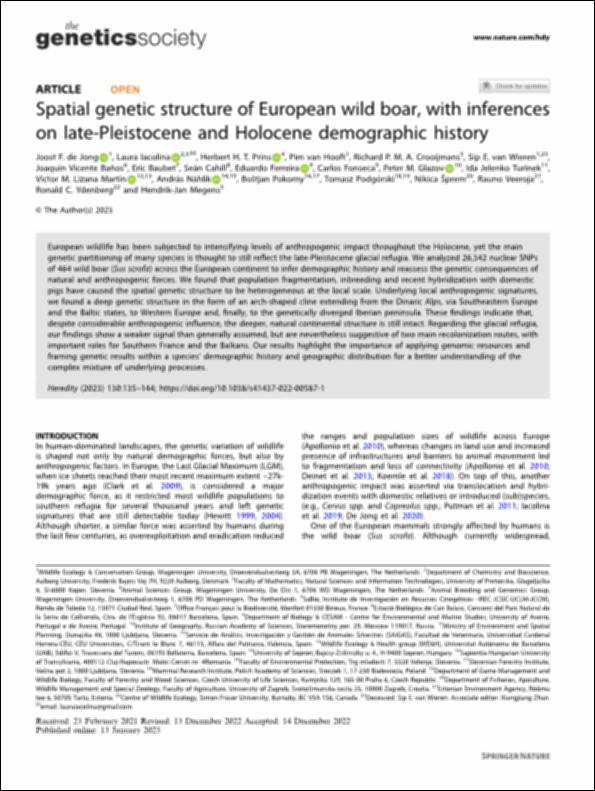Por favor, use este identificador para citar o enlazar este ítem:
http://hdl.handle.net/10637/15144Spatial genetic structure of European wild boar, with inferences on late-Pleistocene and Holocene demographic history
| Título : | Spatial genetic structure of European wild boar, with inferences on late-Pleistocene and Holocene demographic history |
| Autor : | Jong, Joost F. de Iacolina, Laura Prins, Herbert H. T. Hooft, Pim van Crooijmans, Richard P. M. A. Wieren, Sip E. van Lizana Martín, Víctor Manuel |
| Materias: | Jabalíes; Wild Boar; Genética animal; Animal genetics; Demografía; Demography |
| Editorial : | Springer Nature |
| Citación : | de Jong, J.F., Iacolina, L., Prins, H.H.T., van Hooft, P., Crooijmans, R.P.M.A., van Wieren, S.E. et al. (2023). Spatial genetic structure of European wild boar, with inferences on late-Pleistocene and Holocene demographic history. Heredity, vol. 130, i. 3, pp. 135–144. DOI: https://doi.org/10.1038/s41437-022-00587-1 |
| Resumen : | European wildlife has been subjected to intensifying levels of anthropogenic impact throughout the Holocene, yet the main genetic partitioning of many species is thought to still reflect the late-Pleistocene glacial refugia. We analyzed 26,342 nuclear SNPs of 464 wild boar (Sus scrofa) across the European continent to infer demographic history and reassess the genetic consequences of natural and anthropogenic forces. We found that population fragmentation, inbreeding and recent hybridization with domestic pigs have caused the spatial genetic structure to be heterogeneous at the local scale. Underlying local anthropogenic signatures, we found a deep genetic structure in the form of an arch-shaped cline extending from the Dinaric Alps, via Southeastern Europe and the Baltic states, to Western Europe and, finally, to the genetically diverged Iberian peninsula. These findings indicate that, despite considerable anthropogenic influence, the deeper, natural continental structure is still intact. Regarding the glacial refugia, our findings show a weaker signal than generally assumed, but are nevertheless suggestive of two main recolonization routes, with important roles for Southern France and the Balkans. Our results highlight the importance of applying genomic resources and framing genetic results within a species' demographic history and geographic distribution for a better understanding of the complex mixture of underlying processes. |
| URI : | http://hdl.handle.net/10637/15144 |
| Derechos: | Open Access http://creativecommons.org/licenses/by/4.0/deed.es |
| ISSN : | 0018-067X 1365-2540 (Electrónico) |
| Fecha de publicación : | mar-2023 |
| Centro : | Universidad Cardenal Herrera-CEU |
| Aparece en las colecciones: | Dpto. Producción y Sanidad Animal, Salud Pública Veterinaria y Ciencia y Tecnología de los Alimentos |
Los ítems de DSpace están protegidos por copyright, con todos los derechos reservados, a menos que se indique lo contrario.


